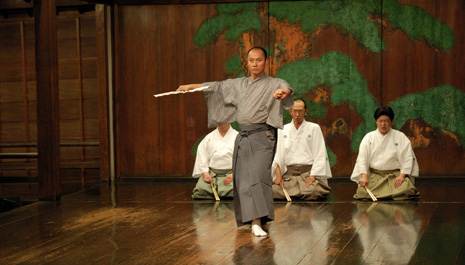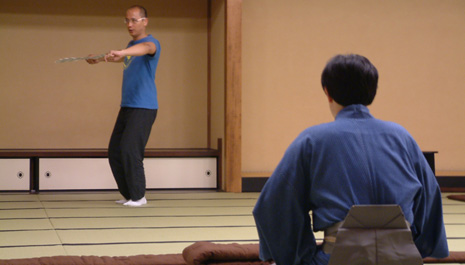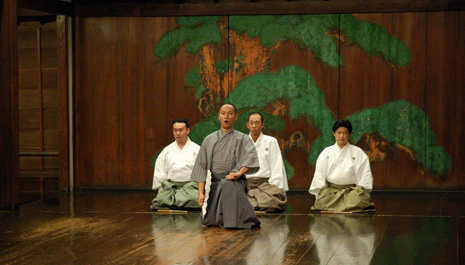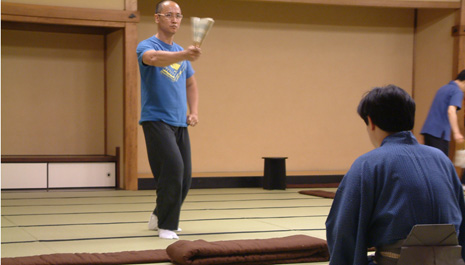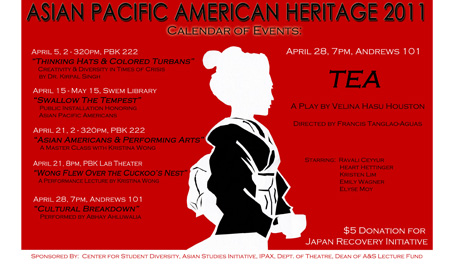W&M theatre professor learns ancient art
William & Mary Theatre Professor Francis Tanglao-Aguas calls Kyoto “the Williamsburg of Japan.” He described the Japanese prefecture as a cradle of traditional culture dedicated to preserving its history, with the key difference between the two sites being that Kyoto “is more than a thousand years old.”
While on scheduled semester research leave last year, the director and playwright spent a month there studying Noh, an ancient Japanese theatre based in movement and music that’s approximately 700 years old. Now that he has returned to William & Mary, Tanglao-Aguas hopes to find innovative ways of passing what he has learned on to his students.
Tanglao-Aguas did not begin his life in the theatre studying traditional Asian performance. As an undergraduate, he trained at UCLA to be an actor, focusing primarily on western performance styles with a focus on Shakespeare. He said that he, like many of his peers, wanted to perform in the popular Broadway shows of the day, such as “Miss Saigon.”
However, while working on his MFA in playwriting, Tanglao-Aguas had a change of heart. As he worked, he began to see elements from the cultures of Nigeria and the Philippines, the countries of his childhood, in the plays he was writing.
“I was seeing more of what I needed from my indigenous culture,” he said
Thanks to a grant from the Freeman Foundation, Tanglao-Aguas was finally able to travel to the region where Noh was born last year. During his time in Kyoto, the director and playwright studied the art form with people who have been in the Noh tradition for generations. Unlike western theatre, the aesthetics of Noh value tradition over innovation, and consequently there are family lines within the theatre that have been playing the same roles for centuries.
The man he studied with was the latest to inherit his role in a long line stretching back for generations, and his knowledge of the piece is considered so complete that he has been designated a national treasure.
The standards and training are likewise very proscriptive and rigorous, and while there, Tanglao-Aguas spent a month of rehearsal learning a three--minute dance.
According to Tanglao-Aguas, the learning process was meticulous.
“For one week I did nothing but learn how to walk,” he said. “But in the official training it’s two years minimum of walking.”
While they did not have time to rehearse an entire play, Tanglao-Aguas and the others in his program learned a variety of traditional Noh songs. The schedule had them practicing three hours a day, five days a week, and the professor spent that entire time focusing on the one dance he was going to perform.
“And at the end of it, I probably had the skill of a 10-year-old,” he added.
As the time drew near for his recital, Tanglao-Aguas said he was worried that, since he didn’t have many acquaintances in Japan at that time, not many people would get to see him perform. He was subsequently very surprised when his performance was sold out.
“I couldn’t believe it,” he said. “During rehearsals I was wondering ‘who’s gonna come, I don’t know anybody here.' But when show time came, the theatre was full. And they paid to watch me.”
Now that he is back at the college, Tanglao-Aguas said that he intends to provide new avenues for his students to study Asian theatre. These include developing three new classes on the subject in addition to the Asian folklore performance class he already teaches, and founding a bi-annual Asian arts ensemble.
“I’m doing this because I want to share this with William & Mary students,” he said.
Tanglao-Aguas also said that he hopes his efforts will enable him to give back to the culture that taught him. Although Kyoto is several hundred miles southwest of the area most affected by last month’s earthquake and tsunami, the theatre professor is no less determined to help the relief efforts.
“The disaster in Japan has inspired me to focus all my creative endeavors as part of the Japan Recovery Initiative to honor my debt of gratitude for the knowledge imparted to me selflessly by my Sensei in Japan, and my warm friendship with many who live there,” he said. Next year the professor is directing a new Japanese play, "Disappearance" by Karalino Sandorovich, and stated that he hopes to use the show to raise funds for the relief effort.
“Noh theatre is a spiritual theatre,” said Tanglao-Aguas. “It simulates the need of living beings to summon spirits to help them.”
The professor said that hopefully what he has learned from the theatre will allow him to help others, whether they are his students or the people who have been living the tradition for generations.














